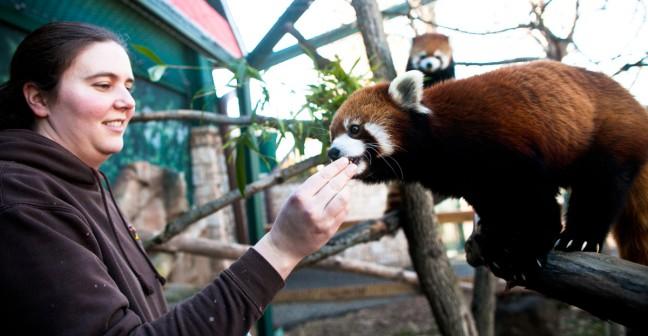The Henry Vilas Zoo welcomed a new batch of exotic animals including a male red panda, who will help the zoo renew their efforts to preserve and protect the endangered species.
According to a statement form the zoo, the park recently obtained three new exotic animals, a male red panda dubbed Lum, an orange-rumped agouti named Steve and a two-year-old female Malayan tapir named Hattie. Deforestation is the primary threat of the extinction for the red panda, while the tapir is endangered because of habitat loss and hunting, the statement said.
The Henry Vilas Zoo is an accredited member of the Association of Zoos and Animals, which is home to the AZA Species Survival Plan Program. According to the organization’s website, the mission of their Species Survival Plan Program is to cooperatively manage a specific, often threatened or endangered, species population within AZA-accredited zoos and aquariums.
Zoo Curator Erin Flynn said the three new inhabitants of the zoo are a part of the Species Survival Program, which works to make pairings based on the animal genetics most conducive to reproduction. It is a significant testament to the network between zoos and how they work with one another, Flynn said.
“If you have a female, and another zoo has a male genetic match, they will generally send the male to the female for breeding purposes,” Flynn said. “You want to have the most genetically valuable matches in a captive population, and our red panda is a very good, healthy female.”
According to the AZA website, as of September, 2001 there are 225 accredited zoos. However, the Henry Vilas Zoo is one of only 71 AZA-accredited zoos in North America that have pandas right now, making it very important for the pandas to breed, Flynn said.
Interim Zoo Director Ronda Schwetz said in a statement the new members of the Henry Vilas Zoo family will help to do even more to educate visitors about the animals and what can be done to preserve them and their habitats.
As a free zoo, Henry Vilas is available to everyone, and there is a lot of community pride that goes into the zoo, Flynn said. There is a large range of visitors, as people can take a leisurely stroll through the zoo on their way to work or visit the zoo with a class.
“The zoo industry has come a very long way, and we are working to preserve these animals in the long run,” Flynn said. “They have top of the line quality exhibits, and they fulfill an important need in the community as far as education goes. People are able to interact in the educational process.”
In the Jan. 23 issue, the Herald printed all AZA zoo members house adopted animals for life. This in fact was not true as AZA zoos actually only house some animals for life. The Herald regrets the error and the online story has been corrected.














